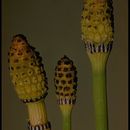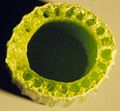en
names in breadcrumbs


Equisetum laevigatum is a rush-like perennial that rises from an underground rootstock structure. Normally the plant dies back over the winter, but some populations in the southwestern USA have individuals that can overwinter. The plant manifests jointed rough stems which are closed at the joints. The stem roughness are a result of inclusions of silica. Each stem exhibits longitudinal grooves that run vertically. Each joint has a sheath which is a minute pointed leaf-like structure. The species usually occurs along moist drainages in sandy and gravelly substrates.
The narrow green stems can attain heights ranging from 30 to 150 centimeters. The stems are generally unbranched and are capped with rounded cone-shaped sporangia. Stomata occur in single lines; moreover, the spherical spores of this species are green.
The appearance of this taxon is very similar to E. hyemale; moreover, The geometric arrangement of silica-tuberles at the shoot surface may be the best means to differentiate these two species.
Equisetum laevigatum , ye una especie perteneciente a la familia Equisetaceae. Ye orixinaria de Norteamérica, sacante pel norte de Canadá y el sur de Méxicu. Alcuéntrase xeneralmente en zones húmedes en sustratos de sable y grava.
Equisetum laevigatum puede ser añal o perenne. Crez dacuando algamando altores cimeros a 1,5 metros. Les fueyes nos nuedos son pequeñes vaines marrones d'aspeutu escamosu y n'ocasiones hai pequeñes cañes delgaes. Los tarmos tán coronaes con esporangios con forma de conos arrondaos .
En Chiapas, Durango y Sonora, emplégase-y pa tratar diversos carecimientos renales como dolor de reñón, retención d'orina y disolución de cálculos renales. Con tal motivu utilícense les puntes de los tarmos en cocimientu alministráu per vía oral. Pa curar el mal d'orín prepárase xuntu con romerillo (Viguiera linearis).[1]
Equisetum laevigatum describióse por Alexander Braun y espublizóse en American Journal of Science, and Arts 46: 87. 1844.[2]
Equisetum: nome xenéricu que provién del llatín: equus = (caballu) y cogorda (gocha).
laevigatum: epítetu llatín que significa "dentada".[3]
 Esta páxina forma parte del wikiproyeutu Botánica, un esfuerciu collaborativu col fin d'ameyorar y organizar tolos conteníos rellacionaos con esti tema. Visita la páxina d'alderique del proyeutu pa collaborar y facer entrugues o suxerencies.
Esta páxina forma parte del wikiproyeutu Botánica, un esfuerciu collaborativu col fin d'ameyorar y organizar tolos conteníos rellacionaos con esti tema. Visita la páxina d'alderique del proyeutu pa collaborar y facer entrugues o suxerencies. Equisetum laevigatum , ye una especie perteneciente a la familia Equisetaceae. Ye orixinaria de Norteamérica, sacante pel norte de Canadá y el sur de Méxicu. Alcuéntrase xeneralmente en zones húmedes en sustratos de sable y grava.
Equisetum laevigatum is a species of horsetail in the family Equisetaceae.[2][3] It is known by the common names smooth horsetail[4] and smooth scouring rush. This plant is native to much of North America except for northern Canada and southern Mexico. It is usually found in moist areas in sandy and gravelly substrates. It may be annual or perennial. It grows narrow green stems sometimes reaching heights exceeding 1.5 meters. The leaves at the nodes are small, scale-like brownish sheaths and there are occasionally small, spindly branches. The stems are topped with rounded cone-shaped sporangia.
Equisetum laevigatum is a species of horsetail in the family Equisetaceae. It is known by the common names smooth horsetail and smooth scouring rush. This plant is native to much of North America except for northern Canada and southern Mexico. It is usually found in moist areas in sandy and gravelly substrates. It may be annual or perennial. It grows narrow green stems sometimes reaching heights exceeding 1.5 meters. The leaves at the nodes are small, scale-like brownish sheaths and there are occasionally small, spindly branches. The stems are topped with rounded cone-shaped sporangia.
Equisetum laevigatum , es una especie perteneciente a la familia Equisetaceae. Es originaria de Norteamérica, excepto por el norte de Canadá y el sur de México. Se encuentra generalmente en zonas húmedas en sustratos de arena y grava.
Equisetum laevigatum puede ser anual o perenne. Crece a veces alcanzando alturas superiores a 1,5 metros. Las hojas en los nudos son pequeñas vainas marrones de aspecto escamoso y en ocasiones hay pequeñas ramas delgadas. Los tallos están coronadas con esporangios con forma de conos redondeados .
En Chiapas, Durango y Sonora, se le emplea para tratar diversos padecimientos renales como dolor de riñón, retención de orina y disolución de cálculos renales. Con tal motivo se utilizan las puntas de los tallos en cocimiento administrado por vía oral. Para curar el mal de orín se prepara junto con romerillo (Viguiera linearis).[1]
Equisetum laevigatum fue descrita por Alexander Braun y publicado en American Journal of Science, and Arts 46: 87. 1844.[2]
Equisetum: nombre genérico que proviene del latín: equus = (caballo) y seta (cerda).
laevigatum: epíteto latíno que significa "dentada".[3]
Equisetum laevigatum , es una especie perteneciente a la familia Equisetaceae. Es originaria de Norteamérica, excepto por el norte de Canadá y el sur de México. Se encuentra generalmente en zonas húmedas en sustratos de arena y grava.
Equisetum laevigatum est une espèce de plantes de la famille des Equisetaceae.
Equisetum laevigatum[1][2] er elfting[3] sem er ættuð frá miðhluta Norður-Ameríku[4] (ekki norður Kanada og ekki suður Mexíkó). Hún getur orðið yfir 1,5 metrar á hæð.
Equisetum laevigatum er elfting sem er ættuð frá miðhluta Norður-Ameríku (ekki norður Kanada og ekki suður Mexíkó). Hún getur orðið yfir 1,5 metrar á hæð.






Equisetum laevigatum là một loài dương xỉ trong họ Equisetaceae. Loài này được A. Braun mô tả khoa học đầu tiên năm 1844.[1]
Equisetum laevigatum là một loài dương xỉ trong họ Equisetaceae. Loài này được A. Braun mô tả khoa học đầu tiên năm 1844.